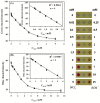3D Microfluidic Devices in a Single Piece of Paper for the Simultaneous Determination of Nitrite and Thiocyanate
- PMID: 32722091
- PMCID: PMC7435404
- DOI: 10.3390/s20154118
3D Microfluidic Devices in a Single Piece of Paper for the Simultaneous Determination of Nitrite and Thiocyanate
Abstract
The concentrations of nitrite and thiocyanate in saliva can be used as the biomarkers of the progression of periodontitis disease and environmental tobacco smoke exposure, respectively. Therefore, it is particularly necessary to detect these two indicators in saliva. Herein, the three-dimensional single-layered paper-based microfluidic analytical devices (3D sl-μPADs) were, for the first time, fabricated by the spraying technique for the colorimetric detection of nitrite and thiocyanate at the same time. The conditions for 3D sl-μPADs fabrication were optimized in order to well control the penetration depth of the lacquer in a paper substrate. Then, the developed 3D sl-μPADs were utilized to simultaneously detect nitrite and thiocyanate and the limits of detection are 0.0096 and 0.074 mM, respectively. What is more, the μPADs exhibited good specificity, good repeatability, and acceptable recoveries in artificial saliva. Therefore, the developed 3D sl-μPADs show a great potential to determine nitrite and thiocyanate for the assessment of the human health.
Keywords: colorimetric analysis; nitrite; spraying; thiocyanate; three-dimensional microfluidic devices.
Conflict of interest statement
The authors declare no conflict of interest.
Figures










References
-
- Huang K.J., Xie W.Z., Zhang H.S., Wang H. Ultra-trace level determination of nitrite in human saliva by spectrofluorimetry using 1, 3, 5, 7-tetramethyl-8-(3, 4-diaminophenyl)-difluoroboradiaza-s-indacene. Microchim. Acta. 2008;161:201–207. doi: 10.1007/s00604-007-0784-1. - DOI
-
- Kodamatani H., Yamazaki S., Saito K., Tomiyasu T., Komatsu Y. Selective determination method for measurement of nitrite and nitrate in water samples using high-performance liquid chromatography with post-column photochemical reaction and chemiluminescence detection. J. Chromatogr. A. 2009;1216:3163–3316. doi: 10.1016/j.chroma.2009.01.096. - DOI - PubMed
-
- Afkhami A., Soltani-Felehgari F., Madrakian T., Ghaedi H. Surface decoration of multi-walled carbon nanotubes modified carbon paste electrode with gold nanoparticles for electro-oxidation and sensitive determination of nitrite. Biosens. Bioelectron. 2014;51:379–385. doi: 10.1016/j.bios.2013.07.056. - DOI - PubMed
Grants and funding
LinkOut - more resources
Full Text Sources

